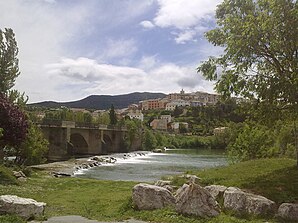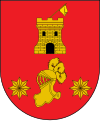Cáseda
| Cáseda municipality | ||
|---|---|---|
 Cáseda - View of the town with Río Aragón
|
||
| coat of arms | Map of Spain | |

|
|
|
| Basic data | ||
| Autonomous Community : |
|
|
| Comarca : | Comarca de Sangüesa | |
| Coordinates | 42 ° 31 ′ N , 1 ° 22 ′ W | |
| Height : | 430 msnm | |
| Area : | 85.61 km² | |
| Residents : | 974 (Jan. 1, 2019) | |
| Population density : | 11.38 inhabitants / km² | |
| Postal code : | 31490 | |
| Municipality number ( INE ): | 31069 | |
| administration | ||
| Website : | Cáseda | |
Cáseda ( Basque Kaseda ) is a place and a municipality (municipio) with 974 inhabitants (as of January 1, 2019) in the autonomous community of Navarre in the north of Spain .
Location and climate
The place Cáseda is located on a hill above the south bank of the Río Aragón at an altitude of approx. 430 m and is approx. 52 km (driving distance) in a south-easterly direction from the regional capital Pamplona . The climate is temperate to warm; Rain (approx. 775 mm / year) falls over the year.
Population development
| year | 1857 | 1900 | 1950 | 2000 | 2017 |
| Residents | 1,579 | 1,610 | 1,886 | 1,060 | 975 |
The mechanization of agriculture , the abandonment of small farms and the resulting loss of jobs have led to a significant decline in the population since the middle of the 20th century ( rural exodus ). The municipality also includes the hamlet (pedanía) San Isidro del Pinar , which is about 12 km south of the village and still has about 25 inhabitants .
economy
Cáseda is traditionally oriented towards agriculture, but craftsmen and service providers have also settled in the village. The viticulture that was once operated in the area came to a standstill in the course of the phylloxera crisis and has only been partially resumed to this day. Tourism in the form of renting out holiday homes (casas rurales) plays a greater economic role.
history
Celtic , Roman , Visigoth and even Moorish traces have not yet been discovered. At the end of the 11th century, Peter I of Aragón (ruled 1094–1104) attempted to recapture ( reconquista ) the area, but only King Alfonso II was successful around 1165. In the 1170s the area was disputed between the kingdoms of Castile and Aragón . Cáseda belonged to the historic Comarca Valle de Aibar until 1843 .
Attractions
- The Iglesia de la Asunción de Nuestra Señora , built in the transition style between late Gothic and Renaissance , is dedicated to the Assumption of Mary and was started in 1531. The west portal is a Gothic step portal with raised archivolts ; the south portal, on the other hand, shows pure Renaissance forms. The nave (nature) is relatively high and of a continuous star-shaped vault covered. There and in the choir area there are several gilded carved altars, under which the main altar protrudes.
- Surroundings
- The Ermita de San Felipe y Santiago is a small, externally undivided, single-nave building that could even have Romanesque origins.
- The Ermita de San Zoilo is dedicated to the martyr Zoilus of Cordoba ; it shows Gothic buttresses on the outside and a large archivolt portal on the south side. The nave and apse are ribbed. Two archaic-looking capitals are interesting .
Web links
Individual evidence
- ↑ Cifras oficiales de población resultantes de la revisión del Padrón municipal a 1 de enero . Population statistics from the Instituto Nacional de Estadística (population update).
- ↑ Cáseda - climate tables
- ^ Cáseda - population development
- ^ Cáseda - San Isidro del Pinar
- ↑ Cáseda - Church
- ↑ Cáseda - Church and Ermitas

